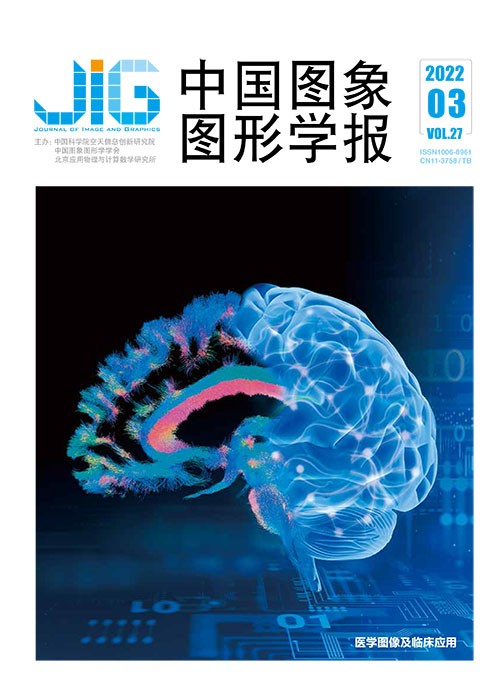
基于深度学习的心脏磁共振影像超分辨率前沿进展
李书林1, 冯朝路1,2, 于鲲1,2, 刘鑫2,3, 江鑫2,3, 赵大哲1,2,3(1.东北大学医学影像智能计算教育部重点实验室, 沈阳 110169;2.东北大学辽宁省医学影像计算重点实验室, 沈阳 110169;3.东软医疗系统股份有限公司, 沈阳 110819) 摘 要
心脏为人体血液流动提供动力,是人体血液循环系统的重要组成部分。受人口老龄化影响,心脏病诊疗已成为重大公共健康话题。非侵入式活体心脏成像对心脏疾病的检测、诊断与治疗意义重大。然而,受活体心跳影响,成像扫描时间与心脏影像分辨率成为难以调和的矛盾。为缓和这一矛盾,基于快速扫描获得的低分辨率影像重建出心脏高分辨率影像的超分辨率(super-resolution,SR)重建技术成为研究热点。深度学习技术在医学影像处理领域中展现出强大生命力,基于深度学习的SR技术因其强大的学习能力与数据驱动性,在心脏影像SR重建领域中表现出明显优于传统方法的性能。目前领域内前沿成果较多,但缺少对领域现状进行总结、对未来发展进行展望的综述性文献。因此,本文对领域内现状进行梳理总结,挑选出代表性方法,分析方法特性,总结文献中心脏影像数据来源与规模,给出常用的评价指标,以及模型得出的性能评价结论。分析发现,基于深度学习的心脏SR重建技术取得了较大进展,但在运动伪影抑制、模型简化程度与时间性能方面仍有进步空间。此外,现有模型基本完全依靠网络强大的表达能力,鲜有临床先验知识的引入。最后,模型间性能对比相对较少,且领域内缺少代表性的可用于评价不同心脏SR重建模型性能的数据集。基于深度学习的心脏影像SR技术仍有较大发展空间。
关键词
Critical review of human cardiac magnetic resonance image super resolution reconstruction based on deep learning method
Li Shulin1, Feng Chaolu1,2, Yu Kun1,2, Liu Xin2,3, Jiang Xin2,3, Zhao Dazhe1,2,3(1.Key Laboratory of Intelligent Computing in Medical Image (MIIC), Ministry of Education, Northeastern University, Shenyang 110169, China;2.Key Laboratory of Medical Image Computing (MIC), Liaoning Province, Northeastern University, Shenyang 110169, China;3.Neusoft Medical Systems Co., Ltd., Shenyang 110819, China) Abstract
Heart diseases diagnosis and treatment has become one of the major public health issues for human beings where non-invasive cardiac imaging is of great significance. Unfortunately, imaging scan time and cardiac image resolution become an intensive contradiction due to the characteristics of living heartbeat. Super-resolution (SR) image reconstruction like low-resolution-images based high-resolution cardiac images reconstruction are obtained based on the determined tolerable error within a short imaging time. Deep learning methods have revealed great vitality in the field of medical image processing nowadays. In terms of its good learning ability and data-driven factors, deep-learning-based SR reconstruction is qualified based on deep residual networks, generative adversarial networks compared with traditional methods. Our research analysis reviews the field via analyzing characteristics of representative methods, summing up cardiac image resources and the scale, summarizing commonly used evaluation indicators, giving performance evaluation and application conclusions of the methods and discussing methods in other fields that can be adapted for SR reconstructing cardiac magnetic resonance (CMR) images. Our analysis is derived from 13 opted literature reviews from Google, database systems and logic programming (DBLP), and CNKI taking deep learning, cardiac and SR reconstruction as search keywords. This review first categorizes all methods by their evaluation datasets, which are open resource or not. Details on the datasets and links to the open-source datasets are also facilitated. By defining standard evaluation indicators based on the reconstructed SR images and their ground truth, namely high-resolution (HR) images, the performance of SR reconstruction methods can be evaluated quantitatively. This demonstration summarizes the 8 evaluation indicators in the cardiac SR reconstruction methods, including structural similarity, cardiovascular diameter measured value, dice coefficient. The evaluation indicators are divided into three categories with respect to the following aspects, those are evaluation of the quality of SR reconstructed images, evaluation of cardiac function and evaluation of the effectiveness of cardiac segmentation. Meanwhile, all 13 literature reviews are only used to increase the spatial resolution of the CMR images. Our research classifies the methods as CMR 2D SR reconstruction, CMR 3D SR reconstruction, and CMR SR reconstruction in other dimensions, depending on the dimension of the cardiac images processing based on the deep learning methods. In general, most CMR 2D SR reconstruction methods can reconstruct high resolution cardiac images in a relative short time span to assure SR reconstruction quality. In contrast, the CMR 3D SR reconstruction methods are involved 3D convolution, which take the spatial structure of the heart into account. The integrated information is analyzed amongst adjacent slices of CMR. Some of these methods achieve the SR reconstruction result qualified than CMR 2D SR reconstruction methods. However, a number of CMR data is small size and most of them are not open. The larger perceptual domain of the methods increases the computation complexity and reduces the temporal performance to some extent. As for CMR SR reconstruction in higher dimensions, corresponding methods meet the requirement of high-resolution image generation and image denoising in clinical analysis. All the selected CMR SR reconstruction methods can also be organized in accordance with network models and high-resolution image degradation methods, such as U-Net, generative adversarial network and long short-term memory network from the aspect of network models. Fourier degradation and different interpolation degradation methods are from the aspect of degradation methods. SR reconstructed high-resolution images can accurately facilitate heart anatomy, blood flow evaluation and heart tissue segmentation level. This research also reviewed the feasibility of adapting other SR reconstruction methods for CMR SR reconstruction as they are currently proposed and applied to images of other in vivo tissues and structures. Our research also tries to find some of the SR reconstruction methods from the field of natural images computer vision to discuss the feasibility that adapting them to CMR SR reconstruction, such as channel attention mechanisms, video SR methods and SR of real scenes. In summary, SR reconstruction of CMR images has its distinctive features than SR reconstruction of natural images like more diverse and purposeful evaluation metrics constraint of local reconstruction quality and to the difficulties of getting training data. It is found that deep-learning-based cardiac SR reconstruction has concerned more in motion artifact suppression, model simplification, and time performance further. In addition, current methods basically rely on the powerful expression ability of the CNN(convolutional neural network), and little clinical prior knowledge is melted to the network to guide its learning. Performance comparison between existing models is relatively less, and there is no representative image repository to evaluate performances of different cardiac SR reconstruction methods.
Keywords
deep learning cardiac imaging super-resolution reconstruction magnetic resonance imaging datasets of cardiac images convolutional neural networks high-resolution images
|



 中国图象图形学报 │ 京ICP备05080539号-4 │ 本系统由
中国图象图形学报 │ 京ICP备05080539号-4 │ 本系统由